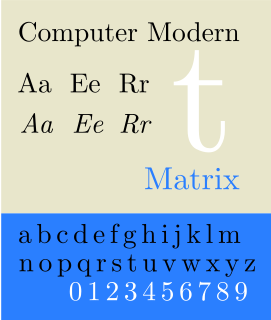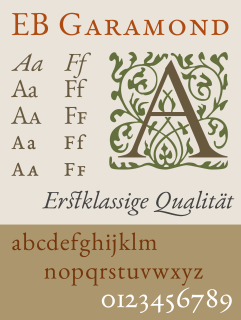
LaTeX is a software system for document preparation. When writing, the writer uses plain text as opposed to the formatted text found in "What You See Is What You Get" word processors like Microsoft Word, LibreOffice Writer and Apple Pages. The writer uses markup tagging conventions to define the general structure of a document, to stylise text throughout a document, and to add citations and cross-references. A TeX distribution such as TeX Live or MiKTeX is used to produce an output file suitable for printing or digital distribution.

In computer text processing, a markup language is a system for annotating a document in a way that is visually distinguishable from the content. It is used only to format the text, so that when the document is processed for display, the markup language does not appear. The idea and terminology evolved from the "marking up" of paper manuscripts, which is traditionally written with a red pen or blue pencil on authors' manuscripts. Such "markup" typically includes both content corrections, and also typographic instructions, such as to make a heading larger or boldface.
TeX, stylized within the system as TeX, is a typesetting system which was designed and written by Donald Knuth and first released in 1978. TeX is a popular means of typesetting complex mathematical formulae; it has been noted as one of the most sophisticated digital typographical systems.
Metafont is a description language used to define raster fonts. It is also the name of the interpreter that executes Metafont code, generating the bitmap fonts that can be embedded into e.g. PostScript. Metafont was devised by Donald Knuth as a companion to his TeX typesetting system.

The device independent file format (DVI) is the output file format of the TeX typesetting program, designed by David R. Fuchs and implemented by Donald E. Knuth in 1982. Unlike the TeX markup files used to generate them, DVI files are not intended to be human-readable; they consist of binary data describing the visual layout of a document in a manner not reliant on any specific image format, display hardware or printer. DVI files are typically used as input to a second program which translates DVI files to graphical data. For example, most TeX software packages include a program for previewing DVI files on a user's computer display; this program is a driver. Drivers are also used to convert from DVI to popular page description languages and for printing.
MetaPost refers to both a programming language and the interpreter of the MetaPost programming language. Both are derived from Donald Knuth's Metafont language and interpreter. MetaPost produces vector graphic diagrams from a geometric/algebraic description. The language shares Metafont's declarative syntax for manipulating lines, curves, points and geometric transformations. However,
dvips is a computer program that converts the Device Independent file format (DVI) output of TeX typography into a printable or otherwise presentable form. dvips was written by Tomas Rokicki to produce printable PostScript files from DVI input, and is now commonly used for general DVI conversion.

Computer Modern is the original family of typefaces used by the typesetting program TeX. It was created by Donald Knuth with his Metafont program, and was most recently updated in 1992. Computer Modern, or variants of it, remains very widely used in scientific publishing, especially in disciplines that make frequent use of mathematical notation.

ΧyMTeΧ is a macro package for TeX which renders high-quality chemical structure diagrams. Using the typesetting system, the name is styled as XϒMTeX. It was originally written by Shinsaku Fujita. Molecules are defined by TeX markup.
The following tables compare general and technical information for a number of document-markup languages. Please see the individual markup languages' articles for further information.
PSTricks is a set of macros that allow the inclusion of PostScript drawings directly inside TeX or LaTeX code. It was originally written by Timothy Van Zandt and has been maintained in recent years by Denis Girou, Sebastian Rahtz and Herbert Voss.

WinEdt is a shareware Unicode (UTF-8) editor and shell for Microsoft Windows. It is primarily used for the creation of TeX documents, but can also be used to edit HTML or any other type of text file. It can be configured to run as a front-end for a variety of TeX systems, including MiKTeX, fpTeX and TeX Live. WinEdt's highlighting schemes can be customized for different modes and its spell checking functionality supports multi-lingual setups, with dictionaries (word-lists) for many languages available for downloading from WinEdt's Community Site. It supports DVI and PDF workflow.
Beamer is a LaTeX document class for creating presentation slides, with a wide range of templates and a set of features for making slideshow effects.

Texmaker is a cross-platform open-source LaTeX editor with an integrated PDF viewer. It is entirely a Qt app. Texmaker supports Linux, macOS and Windows systems and integrates many tools needed to develop documents with LaTeX.

Ipe extensible drawing editor is a free vector graphics editor for creating figures in PDF or EPS format. It can be used for making small figures for inclusion into LaTeX documents as well as making multi-page PDF presentations. It is developed by Otfried Cheong since 1993 and initially worked on SGI workstations only. Ipe 6 was released in 2003 which changed the file format into XML code embedded into PDF and EPS files. Ipe 7 was released in 2009. Ipe 7 can be compiled under Windows, macOS and Unix but binaries are available for many distributions.
The text-producing systems LaTeX and TeX produce DVI files from files written by the user. Those files used to be post-processed by a tool called dvips, which converted those DVI files into PostScript files, which are understood by many printers.
The computer program pdfTeX is an extension of Knuth's typesetting program TeX, and was originally written and developed into a publicly usable product by Hàn Thế Thành as a part of the work for his PhD thesis at the Faculty of Informatics, Masaryk University, Brno, Czech Republic. The idea of making this extension to TeX was conceived during the early 1990s, when Jiří Zlatuška and Phil Taylor discussed some developmental ideas with Donald Knuth at Stanford University. Knuth later met Hàn Thế Thành in Brno during his visit to the Faculty of Informatics to receive an honorary doctorate from Masaryk University.

PGF/TikZ is a pair of languages for producing vector graphics from a geometric/algebraic description, with standard features including the drawing of points, lines, arrows, paths, circles, ellipses and polygons. PGF is a lower-level language, while TikZ is a set of higher-level macros that use PGF. The top-level PGF and TikZ commands are invoked as TeX macros, but in contrast with PSTricks, the PGF/TikZ graphics themselves are described in a language that resembles MetaPost. Till Tantau is the designer of the PGF and TikZ languages. He is also the main developer of the only known interpreter for PGF and TikZ, which is written in TeX. PGF is an acronym for "Portable Graphics Format". TikZ was introduced in version 0.95 of PGF, and it is a recursive acronym for "TikZ ist kein Zeichenprogramm".
Biber is a bibliography information processing program and works in conjunction with the LaTeX package BibLaTeX and offers full Unicode support.

EB Garamond is a free and open source implementation of Claude Garamont’s Antiqua typeface Garamond and the matching Italic, Greek and Cyrillic characters designed by Robert Granjon. Its name is shortening of Egenolff–Berner Garamond which refers to the fact that the letter forms are taken from the Egenolff–Berner specimen printed in 1592.









